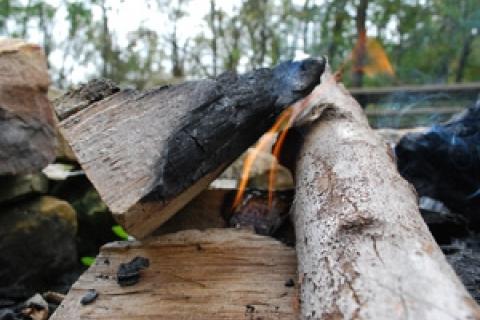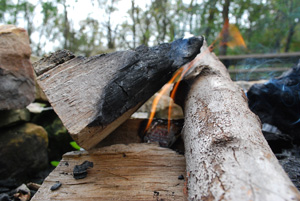
 Pulled over to the side of the park road, I was gazing at several charred tree trunks flanking a specific campsite. The fire-blackened space covered the area of about three average-sized houses. A ranger pulled up beside me and asked if I needed assistance. I asked about the fire scar covering and surrounding the campsite. The ranger shared the story of how two men decided to cook on an open flame, which was contained inside the designated fire ring. It was contained, until the two guys threw their extra firewood in the ring after dinner so they wouldn't have to haul any extra wood home the next day. The region of the campground and state forest was experiencing a period of below-average precipitation — things were dry.
Pulled over to the side of the park road, I was gazing at several charred tree trunks flanking a specific campsite. The fire-blackened space covered the area of about three average-sized houses. A ranger pulled up beside me and asked if I needed assistance. I asked about the fire scar covering and surrounding the campsite. The ranger shared the story of how two men decided to cook on an open flame, which was contained inside the designated fire ring. It was contained, until the two guys threw their extra firewood in the ring after dinner so they wouldn't have to haul any extra wood home the next day. The region of the campground and state forest was experiencing a period of below-average precipitation — things were dry.
The men's extra wood fueled the flames to several feet high with embers taking flight into the neighboring trees. Within a few minutes, the campfire had transformed into a wildfire — a small one that was quickly extinguished by a fire extinguisher carried by a neighboring camper. Thankfully, this wildfire didn't get going, but many times a little spark blooms into a large wildfire resulting in many tragedies. According to the National Park Service, 90 percent of wildfires are caused by humans: burning debris, cigarette butts and campfires. Fire safety should be on every camper's mind when entering the wild country or even at a campsite in a busy campground. Consider the following fire etiquettes when you camp.
Before, or as you arrive at the park or wilderness area, inquire about any fire danger warnings. These may be posted on signs or at information bulletin boards at ranger stations or roadside facilities. Some recreation lands hold year-round open fire regulations and seasons. Be sure of what those regulations are and follow exactly. Not only is that behavior ethical, but also can lead to fines or a court visit if rules are ignored.
If an open flame is legal and suitable for the present situation, proceed with caution and keep the fire small, which equals manageability. When starting a campfire, do not use paper to ignite the kindling. Floating, flaming paper pieces are trouble makers as they land a few yards away from camp, especially when landing on dry tinder. Instead, employ wax/woodchip fire starters, that are easy to use and quick to ignite a campfire.
While the campfire is going, keep an eye on it at all times. Even a small campfire can act ornery with a brief breeze and an ember popping up and out of the fire ring. When the fire has served its duty, extinguish thoroughly. I know that bit of advice is an obvious one, but after logging hundreds of camping hours annually, a just vacated campsite with a smoking fire ring is a common sight — the seed of a wildlife waiting to be born.
During dry seasons and spells, avoiding an open flame at camp is the best choice. Plan meals that don't require flame for preparation, such as cereals, dried fruits, fresh fruits and just-add water packaged meals. Dehydrated meals that are best revived with boiling water and several small backpacking type stoves can do the job safely. Even so, backpacking stoves should not be placed on dry wood or near dry vegetation when in use. Instead, set the little stove on a rock or on bare ground.
The campsite described at the beginning of this blog entry, remains charred one year later. The effects of a wildfire last for years and decades, some change human and wildlife lives forever. It only takes a few seconds or minutes of campfire safety to avoid those tragedies from happening.
- 4221 views

